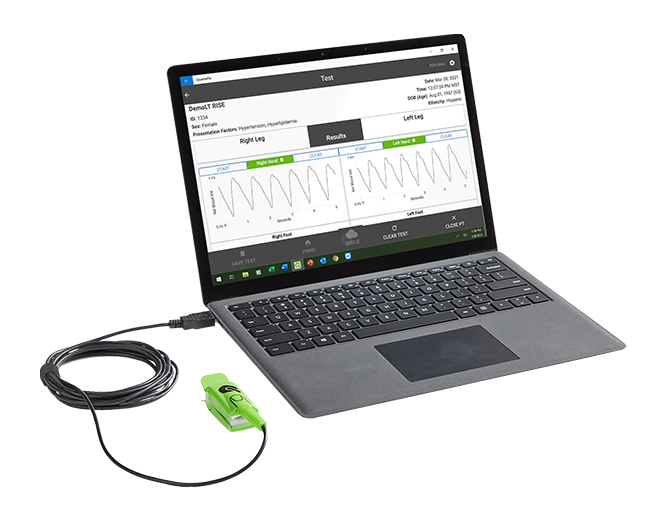Aids in the detection of peripheral arterial disease (PAD) before it’s symptomatic
QuantaFlo® PAD is an easy to use, accurate, point of care, non-invasive solution for patients at risk for peripheral arterial disease (PAD). As published in the Journal of Vascular Surgery and the American Journal of Preventative Medicine, QuantaFlo detected undiagnosed PAD in 31.6% of patients 65 years and over.1
If you have patients 40+ with diabetes mellitus (DM)* you should consider this FDA cleared test.2 The prevalence of PAD in people with DM over the age of 40 is estimated at 20%. For those over 50 with DM it increases to 29%.3
Semler also offers QuantaFlo® HD, an application that aids the provider in the early detection of heart dysfunction. As published in the Journal of Preventive Medicine, QuantaFlo showed a statistically significant correlation with cardiac echocardiography (p<0.01), which is a gold standard for diagnosing heart failure.4
Semler has a suite of solutions that wholly integrate its technologies with its customers’ clinical and operational networks.
Learn more how your practice can start detecting peripheral arterial disease early before it’s symptomatic. Book your FREE demo at 888-340-4881 Press 5 or info@semlerscientific.com.
Benefits of QuantaFlo®:
- FDA cleared
- Early detection of PAD in < 5 minutes
- Actionable and easy to read report
- Reimbursements available in appropriate patients
- Integrates with customers technologies
- Portable and easy to operate
- Non-invasive and painless
- Can be administered by a medical aide
Relevant Clinical Areas:
- Primary care
- Specialty practices
- Home assessments
- Hospitals
- Retail health clinics
- Direct primary care
- And so much more!
References
*2016 AHA/ACC Lower Extremity PAD Guidelines: Age ≥ 65y; Age 50-64y, with risk factors for atherosclerosis; Age <50 y, with diabetes mellitus; and one additional risk factor or atherosclerosis1
- Smolderen KG, Ameli O, Chaisson CE, Heath K, Mena-Hurtado C. Peripheral Artery Disease Screening in the Community and 1-Year Mortality, Cardiovascular Events, and Adverse Limb Events, AJPM Focus (2022), https://doi.org/10.1016/j.focus.2022.100016
- Gerhard-Herman, M. D., Gornik, H. L., Barrett, C., Barshes, N. R., Corriere, M. A., Drachman, D. E., Fleisher, L. A., Fowkes, F. G., Hamburg, N. M., Kinlay, S., Lookstein, R., Misra, S., Mureebe, L., Olin, J. W., Patel, R. A. G., Regensteiner, J. G., Schanzer, A., Shishehbor, M. H., Stewart, K. J., … Walsh, M. E. (2017). 2016 AHA/ACC guideline on the management of patients with lower extremity peripheral artery disease: Executive summary: A report of the american college of cardiology/american heart association task force on clinical practice guidelines. Circulation, 135(12). https://doi.org/10.1161/cir.0000000000000470
- Thiruvoipati, T., Kielhorn, C. E., & Armstrong, E. J. (2015). Peripheral artery disease in patients with diabetes: Epidemiology, mechanisms, and outcomes. World journal of diabetes, 6(7), 961–969. https://doi.org/10.4239/wjd.v6.i7.961
- Howell SC, Master RC (2023) Clinical Evaluation of Volume Plethysmography as an Aid for Diagnosis of Heart Failure in the Primary Care Setting. J Prev Med Vol.8 No.2: 184.

